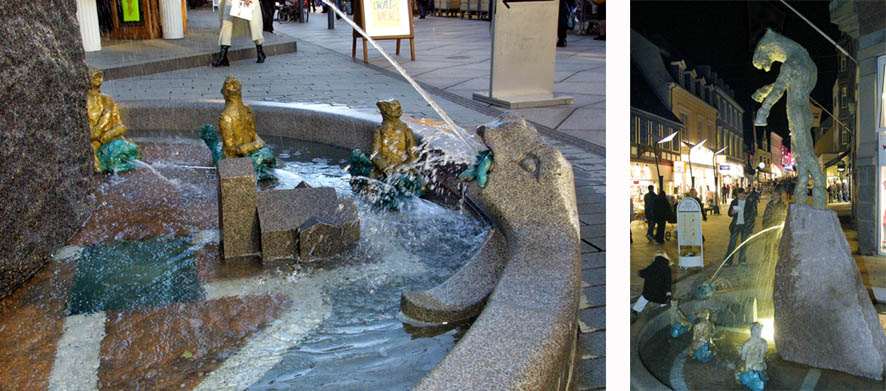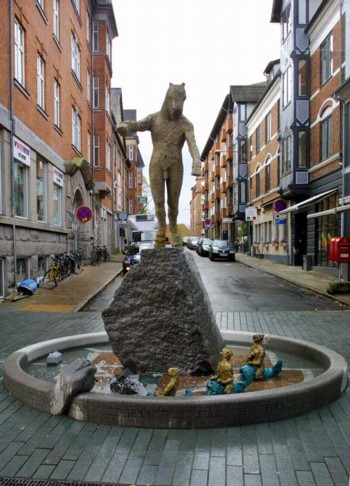Fountain for the pedestrian area in Vejle. A rearing bronze horse on a stone similar to the Runic stones at Jellinge, though without inscription. The horse is protecting the stone against the Midgard serpent that forms a granite wall around the fountain and raises its head to splash water on the horse. The not yet fully grown-up national lions (from the Danish national coat of arms), ride on each their water splashing fish among medieval houses from Vejle. The houses are carved in stone and rise from the water as a vision. The fountain was inagurated 3 november 2001.
A book 24 pages, hardcover, color photographs and text in danish describing the work process, cost 120 DKK, can be ordered from webmaster@kjerrman.dk.
Speech from the inauguration of the sculpture “Midgard-fountain” in Vejle:
I have been working on this fountain for nearly two years now. When I was asked to make a study, I received the history of the town of Vejle in three volumes, which I read thoroughly; I became especially interested in the period up to the end of the eighteenth century. I visited several locations in and surrounding Vejle, among other places the ship, the church and Jelling. It was interesting to learn that Vejle had taken over the position that Jelling had during the Viking age; maybe because it is obvious to place a town where the bay enters the mouth of the inlet. It was also interesting to learn that the architect Christian Drevet in his work with the pedestrian street had taken an interest in Jelling and that he used the inscription from the Jelling stone in some of his stone flags.
Here is the Jelling Stone before it gets an inscription: On the stone Denmark is mentioned for the first time. As the stone is not yet inscribed this takes place before Denmark was born and for this reason the three lions from the Danish national coat of arms are riding as young lions on each their fish.
On one side of the Jelling Stone you see a picture of a fabulous animal fighting with the Midgard Serpent. Here is the fabulous animal on top of the stone and the Midgard Serpent forms the walls of the fountain. The fabulous animal, resembling somehow a wild and stubborn centaur, represents for me the stubbornness that Vejle has demonstrated throughout her history by recovering from wars, fires and other calamities. The Midgard Serpent surrounds the entire world and bites its own tail; in this case the whole world is: the town of Vejle. The serpent also symbolises the sea and the isles surrounding Vejle; the sea is frightening, but at the same time it brings wealth to the city.
Written on the body of the serpent are the dates of all the wars, fires and other calamities which Vejle has overcome.
One of these dates was 1646, when rulers in Copenhagen decided to close down Vejle as a town and move the citizens to Fredericia. However, the citizens of Vejle would not accept this.
The body of the serpent lies on the stone pavement with part of the medieval street net of Vejle marked as a map with stones of different colours.
I have tried to figure out how the children of Vejle can become familiar with their town’s history. Many exciting prospectus (er det flertal ?) exist of Vejle from the seventeenth and eighteenth centuries. Based on them and with a bit of imagination it is possible to see how the buildings of the city must have looked. One of the most striking is the Nikolaj Church that in spite of later rebuilding, looks as before; from photos from late 1800 one can see the old tower, slightly smaller, positioned asymmetrically to the church, giving it a medieval look. On the church there are 23 holes for the sculls of the robbers – as the myth tells. No detailed pictures exist of the city hall, previously a convent. Next to the city hall was the former convent church which, after the Reformation, was neglected and left as a ruin. I have chosen to use the church ruin as overflow, and on the wooden floor with cracks between the floor boards, I have formed a bronze grid where a little Virgin Mary with child stands; I imagine her standing abandoned in the ruins after the Reformation; maybe naughty children threw stones after her and old people shed a tear. The southern gate is one of the buildings, which you notice. On the old pictures it looks as a tall gate; in reality it has presumably not been quite as tall as the pictures of those days try to show rather the importance of the building than the actual size. As in a dream I make Vejle rise from the water with some of the most remarkable buildings from the Middle Ages at the foot of the Jelling Stone. At the same time the fountain retells the pictorial story from the Jelling Stone about the battle between the fabulous animal and the Midgard Serpent.
Vejle, November 3 2001
Pontus Kjerrman

